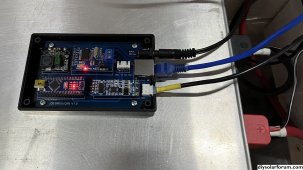Simple Bridge between JBD BMS with a DIY Battery and Solis Hybrid inverter using Pylontech CAN bus protocol.
I have a DIY 16 cell LiFePO4 battery (about 4.5kWh). The BMS used is the JBD-SP25S003-L16S-100A. It was setup as a lead acid battery on my Solis inverter (RHI-3K-48ES-5G) and worked OK for 18 months, as long as you don't over discharge.
But I wanted to send the State of Charge (SoC) of the battery to the inverter to give greater control.
PROJECT HARDWARE
Arduino Nano, RS485 to UART module, MCP2515 CAN bus module and DC to DC converter.
I used the RS485 port on the BMS to get the following data: SoC, Voltage, Current and Temperature.
The data was then converted to PylonTech protocol, which could be read by the inverter.
MCP2515 module using the CAN bus library from coryjfowler, the only library I could get to communicate with Solis.
The Solis inverter was set up with the battery option "Pylon LV", nothing else needed to be done. The max. Voltage, max. Current and max. Discharge was set up in the code and send to the inverter.
Full Project see: github.com/martc55/jbd2solis

I have a DIY 16 cell LiFePO4 battery (about 4.5kWh). The BMS used is the JBD-SP25S003-L16S-100A. It was setup as a lead acid battery on my Solis inverter (RHI-3K-48ES-5G) and worked OK for 18 months, as long as you don't over discharge.
But I wanted to send the State of Charge (SoC) of the battery to the inverter to give greater control.
PROJECT HARDWARE
Arduino Nano, RS485 to UART module, MCP2515 CAN bus module and DC to DC converter.
I used the RS485 port on the BMS to get the following data: SoC, Voltage, Current and Temperature.
The data was then converted to PylonTech protocol, which could be read by the inverter.
MCP2515 module using the CAN bus library from coryjfowler, the only library I could get to communicate with Solis.
The Solis inverter was set up with the battery option "Pylon LV", nothing else needed to be done. The max. Voltage, max. Current and max. Discharge was set up in the code and send to the inverter.
Full Project see: github.com/martc55/jbd2solis

Last edited:



